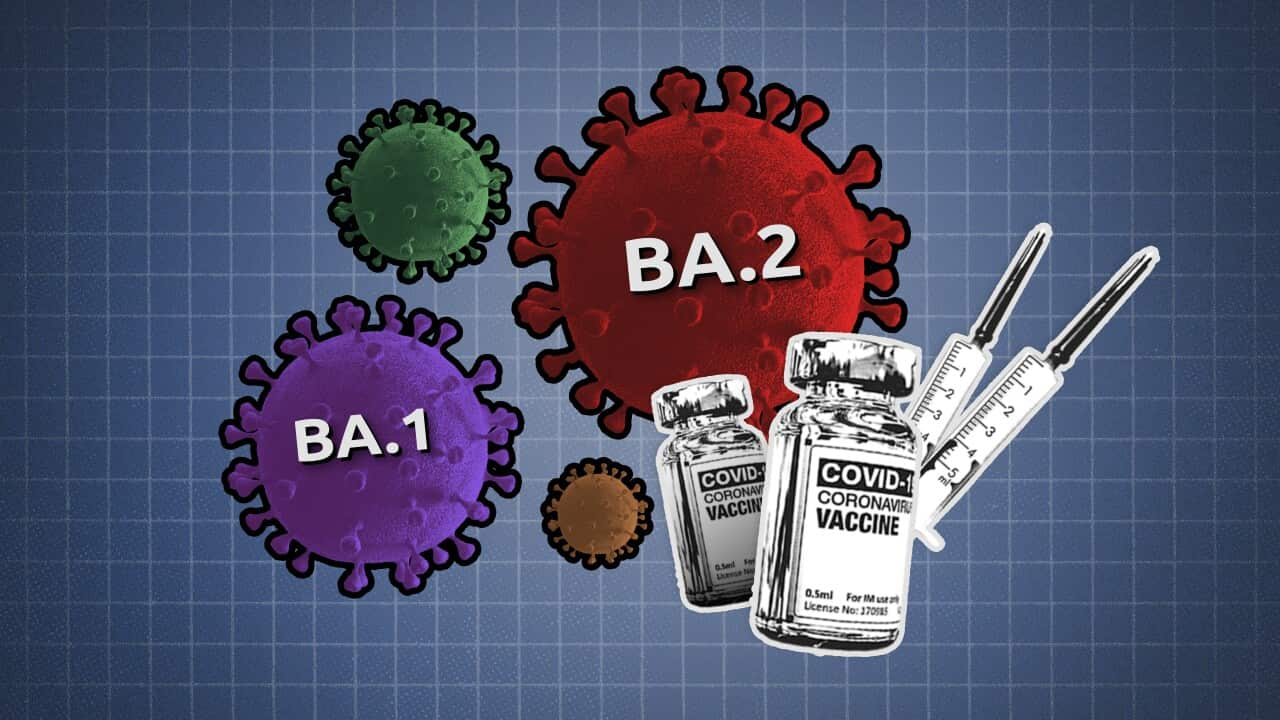As COVID-19 cases rise again in parts of Australia, authorities say the BA.2 variant of Omicron is increasing and could take over as its dominant type.
New South Wales recorded a jump of 3,000 daily infections on Thursday from the previous day.
Experts say the surge is due to both the relaxation of public health measures and the spread of BA.2, which is a sublineage of the Omicron variant.
Speaking at a budget estimates hearing on Thursday, NSW Health Minister Brad Hazzard said preliminary data from University of NSW modelling suggested cases

NSW Health Minister Brad Hazzard. Source: AAP
"While the community may have gone to sleep on the virus, the virus has not gone to sleep on the community."
Here's what we know about BA.2 so far.
What is BA.2?
The Omicron variant of concern is currently the dominant variant of the SARS-CoV-2 coronavirus that is circulating globally.
The World Health Organization (WHO) says Omicron is made up of several sublineages, each of which it is monitoring. Of them, the most common are BA.1, BA.1.1 and BA.2 — along with BA.3.
"BA.3 is apparently quite rare, so we don't know much about it. BA.1 was the original Omicron variant, which basically dominated the world," said epidemiologist Professor Adrian Esterman, from the University of South Australia.
"But we've now learned about BA.2, which is the subvariant or sister of BA.1."
BA.2 was first detected in the Phillippines last November and, by February, had been discovered in 57 countries, the WHO said at the time.
Professor Esterman said BA.2 now makes up about a quarter of Australian cases.
"In Denmark, almost 100 per cent of all cases are now BA.2. In Australia, it's about 25 per cent. But two weeks ago, it was 10 per cent," he said.
"In two weeks' time, it will probably be 100 per cent."
In its latest statement, the WHO said "the BA.2 sublineage should continue to be considered a variant of concern and that it should remain classified as Omicron".
What do we know about it?
BA.2 has a different genetic sequence to BA.1, including some amino acid differences in the spike protein and other proteins, the WHO says.
"The first thing is it is incredibly transmissible and taking over from BA.1," Professor Esterman said.
This is backed up by the WHO, which says initial data suggests BA.2 appears inherently more transmissible than BA.1, which remains the most common Omicron sublineage reported.
But Professor Esterman said BA.2 does not appear to be more severe than BA.1 when it comes to disease outcomes.
"We're seeing very similar rates of hospitalisation and intensive care unit (ICU) admissions for both BA.1 and BA.2," he said.
"And we know that it has the same ability to evade the immune system as BA.1 does. So for all intents and purposes, you can think of it as identical to BA.1, but much more transmissible."
He said cases in Victoria, while currently fairly stable, could rise, while numbers in South Australia and Tasmania are increasing.
Deputy Chief Health Officer Dr Sonya Bennett said on Friday BA.2 is increasing across states, which was "expected".
"We’ve seen it internationally. We know that it’s more transmissible, which is why it is overtaking the BA.1 variant of Omicron," she said.
"But it doesn’t appear to result in more severe clinical outcomes and the vaccine appears to be as effective against [the] BA.2 Omicron variant, as BA.1."
Are vaccines effective?
Professor Esterman said BA.2 is very similar to BA.1 in all aspects of immunity — including vaccine protection.
"So what we know is that two doses of existing vaccines provide virtually no protection against infection from Omicron — whether it's BA.1 or BA.2, " he said.
"Having a third dose does provide you protection against infection.
"Now we’re seeing the same for third doses where we are getting that waning of immunity. And there is data from Israel that shows even after a fourth dose, you get a waning immunity."
He said the population remains "quite well protected" from severe illness, which explains why hospitalisations are not increasing.
But protection against infection remains a concern for vulnerable groups and the elderly.
Authorities are urging Australians to come forward for their booster shot — especially ahead of winter, when they're expecting a rise in COVID-19 cases and influenza circulating.
"Two doses is not as effective as three for Omicron, so the evidence is very clear that a third dose of COVID vaccine is required to really lift your protection from severe disease as well as infection for Omicron," Dr Bennett said.
Federal Health Minister Greg Hunt said a booster shot is an important part of one's protection "even if you've had Omicron".
"It’s not over, and there will inevitably be new variants, and there will inevitably be a level of virus within the community going forward," he said on Friday.
Should we be concerned?
While authorities say the growing prevalence of BA.2 was expected, Professor Esterman believes the level of concern in Australia should be "much more" than present.
"People are sick to the teeth of COVID-19 — I don't blame them. And according to all our state and territory governments, it is over," he said.
"The trouble is the virus doesn't know that; it is still there, quite happily infecting people.
"Case numbers do matter. And we should be concerned about BA.2."
He said governments should be "more cautious" about removing existing public health measures.
"I'm not saying we don't take them off. I'm saying we should be more cautious about it — and certainly be willing to put them back on quickly if numbers start exploding."
In the meantime, he encouraged vulnerable or elderly members of the community to continue wearing face masks and take precautions.
"We can take these things off [restrictions], but we still have to protect vulnerable people."











